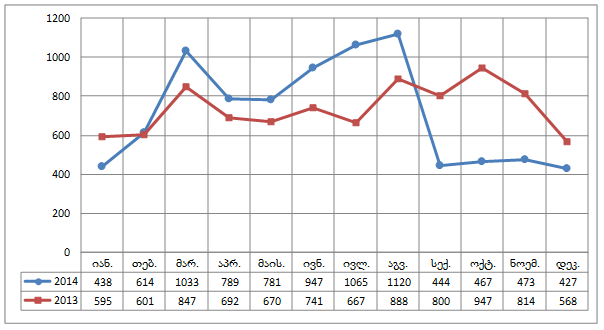On 13 January 2015, at the Georgia-Estonia Business Forum, the Prime Minister of Georgia, Irakli Gharibashvili, spoke about the conditions that Georgia offers to investors in terms of making business and development. Mr Gharibashvili also noted: “In two years, export from Georgia has increased by 24%. In the same period, export to the European Union increased by 70%. It is a very important achievement as 80% of the terms and conditions comprising the Deep and Comprehensive Free Trade Agreement were enacted on 1 September 2014 with the remaining 20% forthcoming.”
FactCheck took interest in the Prime Minister’s statement and verified its factual accuracy.
In 2013, Georgia’s export increased by 22% and amounted to USD 2,908 million. In 2014, the volume of export decreased by 2% and comprised USD 861 million. In total, the volume of export has increased by 20.5% over two years.
After 2009, 2014 turned out to be the least successful year for Georgia in terms of export. A decrease in export in the period of 2004-2014 was only recorded in 2009 and 2014. As a reminder, 2009 is the year after the 2008 Russia-Georgia war and the period of the world economic crisis.
Graph 1: Export Growth Rate in 2008-2014
As for the growth of export to the EU, export to the countries of the EU increased by 72% in 2013 whilst it increased by 2% in 2014. In 2012, the volume of export to the countries of the EU totalled USD 353 million whilst it grew to USD 621 million in 2014, constituting a 76% increase.
The Deep and Comprehensive Free Trade Agreement (DCFTA) between Georgia and the EU came into force on 1 September 2014. The DCFTA grants Georgia the free movement of goods, services and capital on the domestic market of the EU. Despite the DCFTA coming into force in September, it has not yet affected the volume of export. In September 2014, the volume of export with the countries of the EU was nearly identical to the same index of the previous year whilst export to the EU decreased significantly from the month of October.
It is noteworthy that export to the countries of the Commonwealth of Independent States (CIS) decreased by 10%. Moreover, export to Georgia’s largest partner in terms of export, Azerbaijan, shrank by nearly USD 165 million. Among the other various trade partner countries, export has also decreased to Armenia, Ukraine and Kazakhstan. In 2014, growth in export was recorded to Russia, Turkey, the US and China.
Graph 2:
Source: National Statistics Office of Georgia
Conclusion
The volume of export grew by 20.5% in two years whilst export to the countries of the EU increased by 76%. The average increase in export in the last two years looks impressive owing to the 22% increase in 2013. The year 2014, however, was unsuccessful in terms of export. In 2014, the volume of export decreased by 2% as compared to the last year. Export to the countries of the Commonwealth of Independent States has decreased significantly whilst export to the EU has increased by only 2%.
Even though the number stated by the Prime Minister, 24%, does not greatly differ from the real number (20.5%), it should be considered that the Prime Minister disguised the negative export index of 2014 by summing together the last two years and tried to positively display Georgia’s export trends.
Considering the given context, FactCheck concludes that Mr Gharibashvili’s statement is MOSTLY FALSE.

“In two years, export from Georgia has increased by 24%. In the same period, export to the European Union increased by 70%.”
29/01/2015
Mostly False
In the statement is the elements of the truth, but the important facts that could have made other impressions
Persons
-

“Georgia’s economy will surpass GEL 100...
Without verdictThe verification of the application can not be evaluated -

“Caring for emigrants is a priority of o...
FalseThe statement is inaccurate -

“The average teacher salary increased by...
Mostly TrueThe application is accurate, but requires additional information and/or definition





